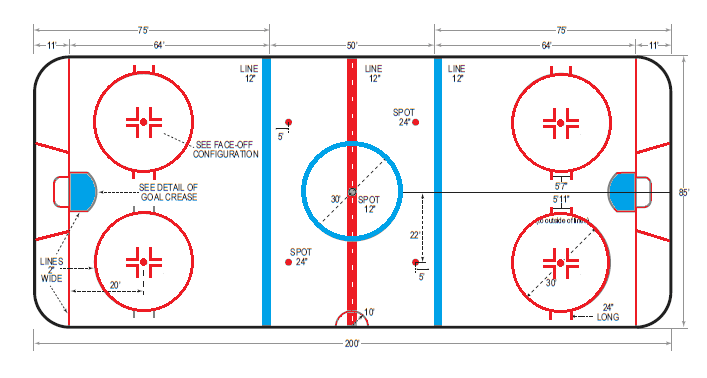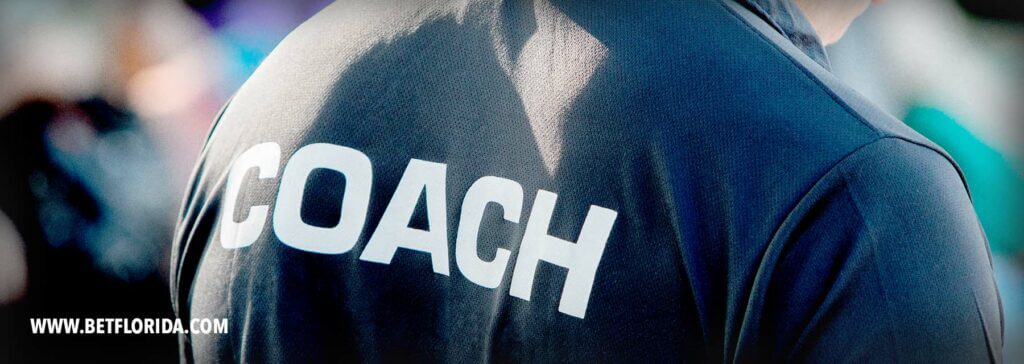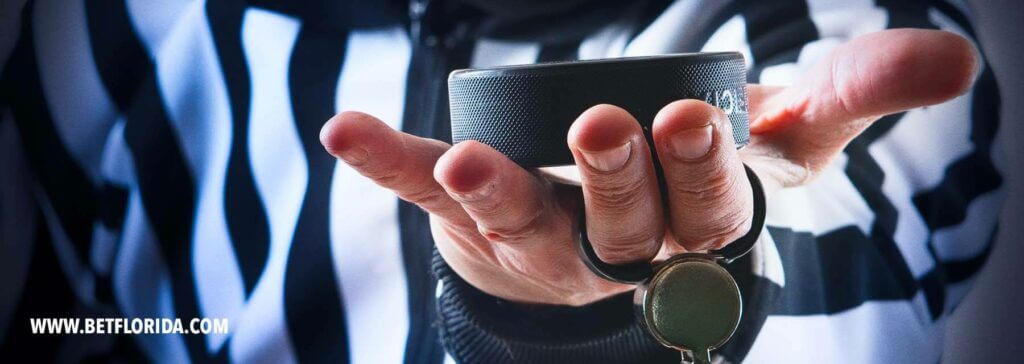Basic NHL Rules
There are two Florida teams in the NHL: the Florida Panthers and the Tampa Bay Lightning. While bookmakers may not set up gambling sites in the United States, punters can still bet on international websites that permit US gamblers.
You need to understand how the rules affect your NHL betting to wager correctly on the NHL markets. We’re going to take a detailed look at how the rules work. Moreover, we’ll also provide some guidance as to how new rules have brought some changes to the game.
Before we get into the guide’s detailed section, we’ll need to understand how the game works. There are some basic rules that all teams must follow. It directs what each side may and may not do and governs the roles of each player.
Game Objective
NHL rules state that in order to win, one side must score more points than the other.
There are three stages of play, each consisting of 20 minutes. If the game results in a draw, then an extra five minutes is allowed for sudden death. Whoever scores the next goal in that time period is the winner.
The rulebook states that a hockey stick must be used to strike the puck into the net. Players may not kick or use any parts of their body to move it around. There are two referees and two linesmen present to enforce the NHL rules during gametime.
Court / Field
The above image represents the court outline from the official NHL rule book. It shows the different play areas for the two teams, as well as goals and defense lines. Every hockey rink where NHL matches take place must follow the indicated measurements.

The central face-off circle is where the referee puts the puck into play. Only one player per team may enter the circle at this stage. As soon as the puck hits the ice, both sides may attempt to claim it and drive it towards the opponent’s goal post.
The two blue lines indicate the neutral zone in the middle between them, with defensive zones on the outer sides. The two outer red lines represent the goal lines. All of these zones and lines are vital for determining foul play and violations.
There are four other face-off zones, two in each defense area. The referee will resume play after a violation by dropping the puck in one of these face-off zones. One team’s defensive zone is another team’s offensive zone.
Player Roles
According to NHL rules, each team has six players on the court at any given time. This consists of the goalie, two defenders and three forwards. While the forwards attempt to push the puck towards the goal, the defenders prevent the opponents from scoring against them.
The goalie rarely leaves the goal area, stopping the opponents from scoring goals. However, the goalie may step away near the end of the game for an offensive player to guard the net. Furthermore, there are different names for various roles in the team:
- Sniper: similar to a striker in soccer, the sniper attempts to score the goals.
- Playmaker: these players use open spaces to set up the strikes for snipers.
- Power forward: large players that battle with opponents to win the puck.
- Two-way forward: players who can switch to defensive in specific instances.
- Grinder: the biggest forwards used for stopping penalties and shots.
- Enforcer: the most aggressive players who rough up opponents and defend teammates.
- Offensive defenseman: fast defenders who sometimes snipe at the opponent’s goalie.
- Shutdown defenceman: players who stop snipers from scoring goals.
Scoring in Hockey
A player scores a goal when the puck enters the goal post behind the goalie. It must cross the red line while staying below the crossbar. If the puck crosses the border without entering the goal post, then it doesn’t count.
There are specific instances where the referee disqualifies the goal, even if the puck enters the net. In most cases, it happens when the striking team commits a foul while scoring. For instance, when the sniper lifts his stick higher than the crossbar while striking.
If the referee blows the whistle while the puck is on its way into the net, the goal won’t count. This event usually occurs when the offensive team has caused a foul while sniping. Furthermore, it won’t count if the puck deflects off a linesman or referee into the net.
The linesman may also pick up on minor or major penalties before scoring the goal. The puck sometimes deflects off a player’s body during play. While it could be accidental, the referee won’t allow it.
Player and Team Rules
There are specific rules assigned for players and for the team when it comes to the NHL. Before any team can qualify for a season, they need to ensure that they’ve met all the regulations. If they don’t, then the NHL will exclude them from playing for the season.
The first rule is that teams must submit their roster of players before the start of the season. The roster can be between 20 and 23 players. However, any injury reserves don’t count towards the team total.
There is a similar rule for each NHL game. Before the game starts, the coach must hand in the roster of players for the event. Each time may not bring more than twenty players to the match. Furthermore, only the coach may be present without an official team uniform.
If anyone discovers that any there are players not on the list, then they are ineligible to play in the game. There are cases where it’s found during the game, with the ineligible player already on the ice. The referee will disqualify any goals made during discovery.
It’s vital to note that the referee may allow goals made before discovery. This ruling is critical for NHL betting, mainly on markets where the number of goals is a deciding factor. The coach must remove ineligible players without providing a substitute.
Coach Rules
It’s not only the team players that must abide by the rules but also the coach. Similar to before, the team must also list who the coach is in the roster.

The coach is the only team member who may sit on the coach bench. Moreover, a non-uniformed person may join the coach, as long as they are on the list.
The coach must provide the starting line-up for the game. Once submitted, the coach can’t change it unless the referee approves it. If the team violates this rule, then the referee will impose a penalty on them.
Finally, the coach must choose a captain to represent the team on the ice. Only the captain may ask questions or raise issues with the referee. If the coach wants a matter addressed, then he needs to inform the captain.
Time Limits and Game Duration
There are specific NHL rules set out for the duration of the game, as well as time limits for periods and intermissions. These stipulations govern the length of each period so that the audience and punters know how long to wait. It’s also vital so that you can monitor the in-play markets during the game.
An NHL game has three periods of 20 minutes each. Furthermore, the intercessions between periods last up to 18 minutes. The Game Timekeeper keeps track of the time, displaying it on the scoreboard.
Sometimes, events occur that delay the game. While the game is underway, these delays don’t usually cause a problem. However, if the delay happens during the last five minutes of a period, the referee may call for an intercession early. They will add the time lost to the start of the next period of play.
Overtime Rules
A game goes into overtime when the final result is a draw. While each team receives a point for the tie, the game proceeds into overtime. After they shovel the ice, the five-minute timer begins.
The game will end as soon as one team scores. Furthermore, the winning team will receive an additional point in the League standings. There will also be an extra goal difference for the game.
A minimum of three skaters may play in overtime. If the coach calls for the goalie to leave the court, then he may add a fourth skater. Penalties incurred during the game may also cause extra players to join the opposing team.
The excitement increases when the overtime period ends in a draw. New markets open up on sportsbooks for the final shootout. In this final stage, each team has three shots at goal to win the match. They will continue to play until there is a definite winner.
Fouls and Violations
The NHL rulebook lists four main categories of fouls. Each of them has several types of violations that players can commit during a game, together with the suitable punishment. Some of the fouls will result in a penalty, while others only require a stern warning.
The first category is physical fouls. As the name implies, these types of errors exist where players make physical contact with each other.

Some are more serious than others. Physical fouls include Charging, Clipping, and Elbowing. Altogether, there are a total of 13 violations listed in this section.
The next category is restraining fouls. These violations occur when a player physically impedes the flow of the game. There are only four listed, namely Holding, Tripping, Interference, and Hooking.
Stick fouls fall under the third category. It specifically deals with the handling of the hockey stick, as well as violations caused by it. They are different from physical fouls in that the stick causes the violation. There are six stick violations, including Spearing, High-sticking, and Butt-ending.
Finally, there are 13 violations listed as ‘Other Fouls.’ It covers any fouls not listed in the above categories. It could result from a player refusing to play the puck, equipment fouls, or simply delaying the game.
Equipment
The NHL makes it clear to teams how equipment needs to keep to regulations. There are penalties in place for infringements, such as using illegal equipment. The rules ensure that no teams have an unfair advantage.
Some stipulations have nothing to do with game advantage. Uniforms must adhere to strict measurements and placement of emblems. When it comes to the hockey sticks, the rules go as far as stating the material and required length.
Referee and Procedures
The one person you’ll rely on to maintain order on the court is the referee. Yet, set rules also bind them to specific regulations. If a referee makes an incorrect call, then it can adversely affect the outcome of the game and your wager.
Besides needing to wear a specific uniform set by the NHL Board, they need to learn hand signals. The rulebook lists 34 signs in total, all of which the referees and linesmen must know by heart. Furthermore, they must remember all possible violations and penalties.
Player Trading Rules
An NHL contract is required in order for players to take part in league matches. The contract specifies when trading can take place, or if any clauses enforce no movement. These contracts ensure that players abide by the rules of the game.
Trading takes place forty days after the final game of the previous season. Teams can still trade players after the deadline, but they won’t be eligible to play in the NHL.
New Changes in Rules
The NHL Board reviews the league rules every year to see where they can improve them. Some of these rules have a significant effect on sports betting markets, specifically where teams have new advantages. You should always confirm what the latest regulations are and how it affects you.
Some of the latest rule changes include the following:
- There are new video reviews for major penalties;
- Coaches may request reviews for issues in the game;
- Teams can decide where to hold face-offs on the court;
- There are extra situations where teams can’t change lines;
- The helmet rules are stricter.
Frequently Asked Questions (FAQ)
- Players are not allowed to kick the puck into the net with purpose
- Maximum 5 players and 1 goalie at the ice at the same time
- The puck carrying players must always enter the opposing teams zone first